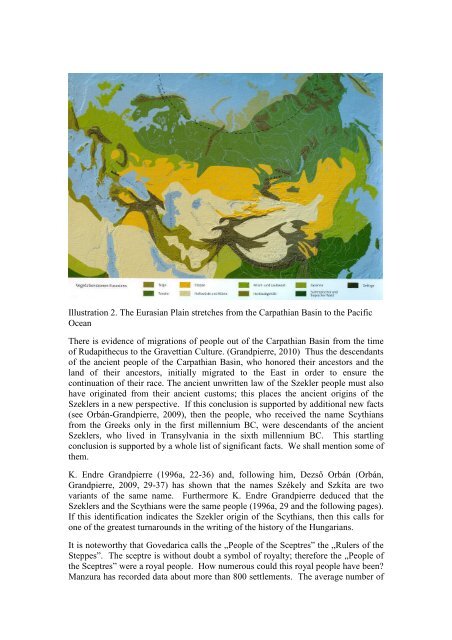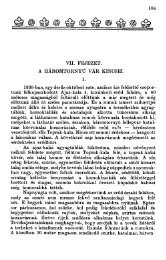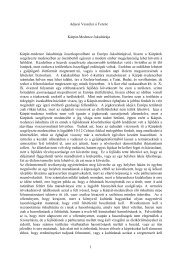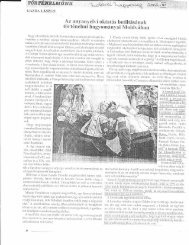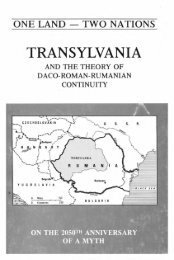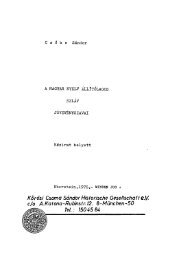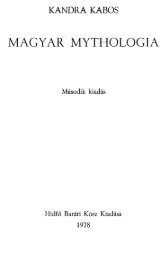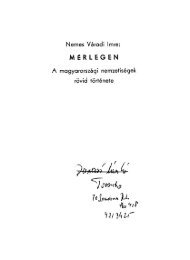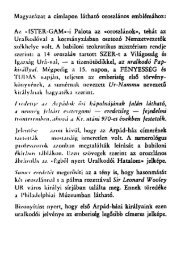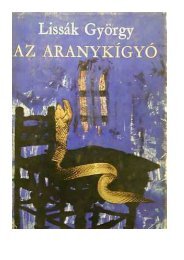The Szekler Origins of the Scythians
The Szekler Origins of the Scythians
The Szekler Origins of the Scythians
You also want an ePaper? Increase the reach of your titles
YUMPU automatically turns print PDFs into web optimized ePapers that Google loves.
Illustration 2. <strong>The</strong> Eurasian Plain stretches from <strong>the</strong> Carpathian Basin to <strong>the</strong> Pacific<br />
Ocean<br />
<strong>The</strong>re is evidence <strong>of</strong> migrations <strong>of</strong> people out <strong>of</strong> <strong>the</strong> Carpathian Basin from <strong>the</strong> time<br />
<strong>of</strong> Rudapi<strong>the</strong>cus to <strong>the</strong> Gravettian Culture. (Grandpierre, 2010) Thus <strong>the</strong> descendants<br />
<strong>of</strong> <strong>the</strong> ancient people <strong>of</strong> <strong>the</strong> Carpathian Basin, who honored <strong>the</strong>ir ancestors and <strong>the</strong><br />
land <strong>of</strong> <strong>the</strong>ir ancestors, initially migrated to <strong>the</strong> East in order to ensure <strong>the</strong><br />
continuation <strong>of</strong> <strong>the</strong>ir race. <strong>The</strong> ancient unwritten law <strong>of</strong> <strong>the</strong> <strong>Szekler</strong> people must also<br />
have originated from <strong>the</strong>ir ancient customs; this places <strong>the</strong> ancient origins <strong>of</strong> <strong>the</strong><br />
<strong>Szekler</strong>s in a new perspective. If this conclusion is supported by additional new facts<br />
(see Orbán-Grandpierre, 2009), <strong>the</strong>n <strong>the</strong> people, who received <strong>the</strong> name <strong>Scythians</strong><br />
from <strong>the</strong> Greeks only in <strong>the</strong> first millennium BC, were descendants <strong>of</strong> <strong>the</strong> ancient<br />
<strong>Szekler</strong>s, who lived in Transylvania in <strong>the</strong> sixth millennium BC. This startling<br />
conclusion is supported by a whole list <strong>of</strong> significant facts. We shall mention some <strong>of</strong><br />
<strong>the</strong>m.<br />
K. Endre Grandpierre (1996a, 22-36) and, following him, Dezső Orbán (Orbán,<br />
Grandpierre, 2009, 29-37) has shown that <strong>the</strong> names Székely and Szkíta are two<br />
variants <strong>of</strong> <strong>the</strong> same name. Fur<strong>the</strong>rmore K. Endre Grandpierre deduced that <strong>the</strong><br />
<strong>Szekler</strong>s and <strong>the</strong> <strong>Scythians</strong> were <strong>the</strong> same people (1996a, 29 and <strong>the</strong> following pages).<br />
If this identification indicates <strong>the</strong> <strong>Szekler</strong> origin <strong>of</strong> <strong>the</strong> <strong>Scythians</strong>, <strong>the</strong>n this calls for<br />
one <strong>of</strong> <strong>the</strong> greatest turnarounds in <strong>the</strong> writing <strong>of</strong> <strong>the</strong> history <strong>of</strong> <strong>the</strong> Hungarians.<br />
It is noteworthy that Govedarica calls <strong>the</strong> „People <strong>of</strong> <strong>the</strong> Sceptres” <strong>the</strong> „Rulers <strong>of</strong> <strong>the</strong><br />
Steppes”. <strong>The</strong> sceptre is without doubt a symbol <strong>of</strong> royalty; <strong>the</strong>refore <strong>the</strong> „People <strong>of</strong><br />
<strong>the</strong> Sceptres” were a royal people. How numerous could this royal people have been<br />
Manzura has recorded data about more than 800 settlements. <strong>The</strong> average number <strong>of</strong>


